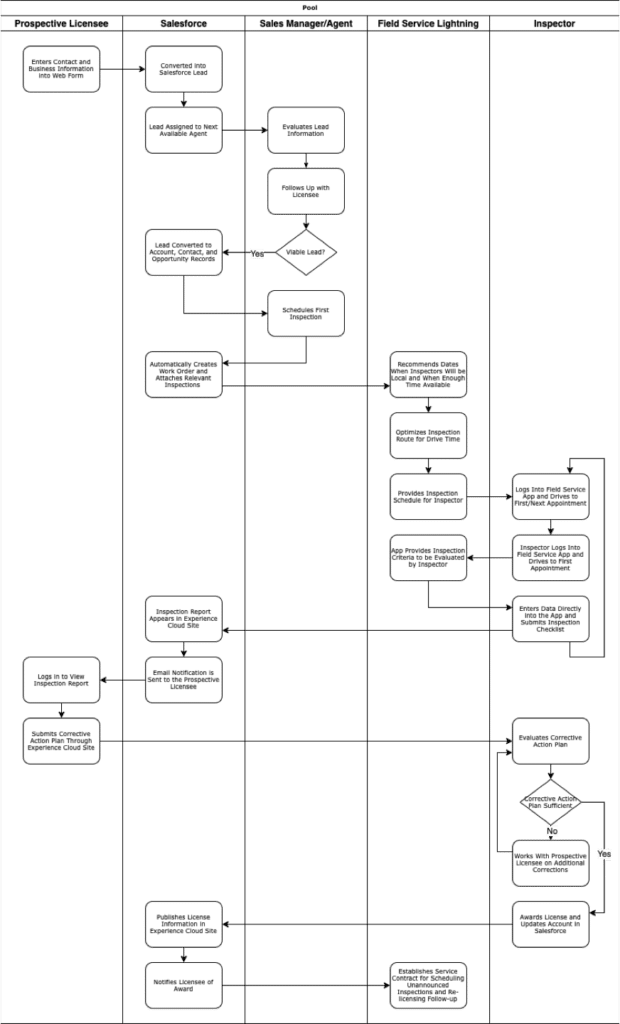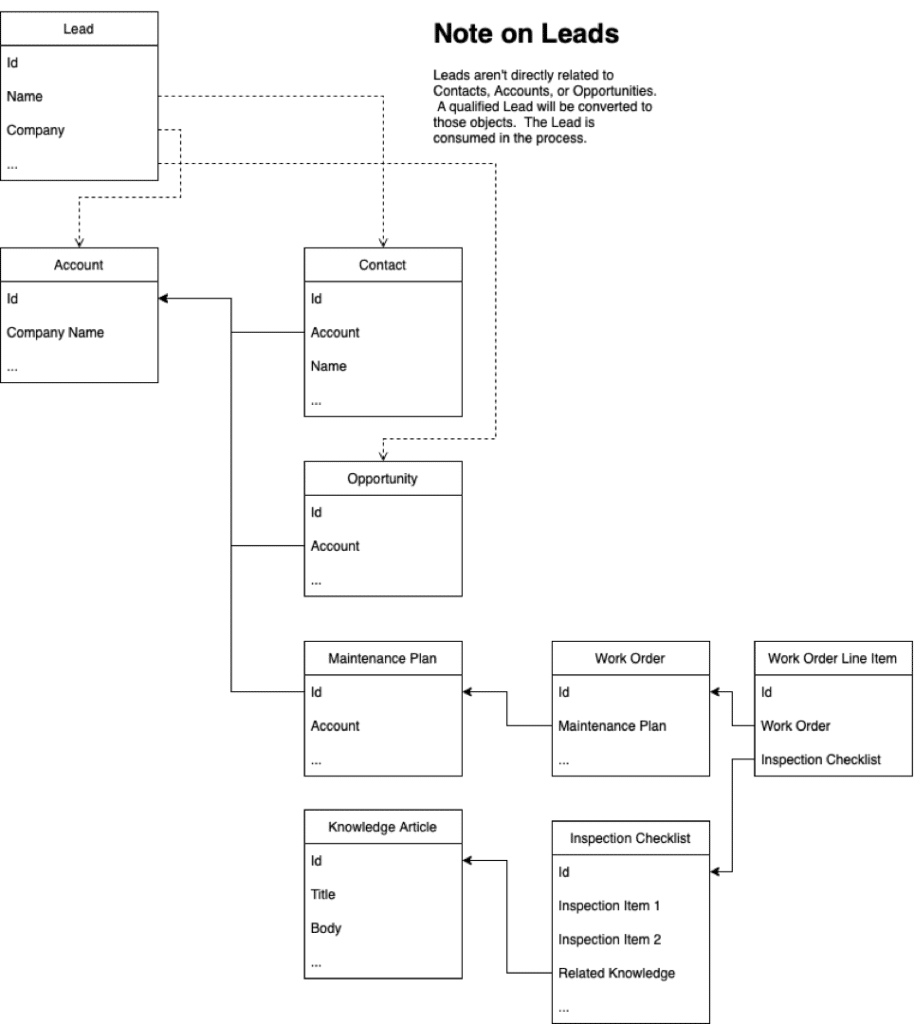For a job application, I was asked to put together a project plan for a Licensing company looking to use technology to revamp one or more business processes. I’ll attach the request document here, and then include my response. I’ve built the entire solution using Salesforce, with a combination of core and add-on functionalities, intending to cover all aspects of the business process.
Technical Solution Proposal
I’ve taken the approach of a cost-no-object solution. There are other options available to handle a handful of these requirements, and I’ll try to call those out as other possible options. For diagrams, swim lanes, etc. I’ll be drafting them just for the main, cost-no-object solution. I can speak to those other options if needed. The intention is to use the right Salesforce tool for the job, rather than proposing a bunch of abstract configuration.
Receiving New Customer Applications (Web-to-Lead)
Recommended Components:
- Standard Object: Lead
- Configured Feature: Web-to-Lead Form
The built-in web-to-lead form can be used to handle new potential customer onboarding, allowing you to leverage the built-in processes for converting a Lead into a Contact and Opportunity. This abstraction can be hidden if the customer is not interested in following a lead process with some automation to automatically convert that lead into an Opportunity and Contact record.

Leads can be automatically or manually assigned to a Sales Manager based on region or availability. If there is a team that handles pre-processing of leads, Omni-channel can be used for routing Leads to the pre-processing team who can evaluate and contact the prospective customer about missing or invalid information.

Alternatives:
Given that the Web-to-Lead form has some data type restrictions, it may be desirable to move toward an Experience Site which offers more built-in functionality. I propose further down the implementation of an Experience Site, but it is not a hard requirement to accomplish the customer’s goals, and may not be required to fulfill the needs of the Lead form.
Inspection Checklist (Custom Object)
Recommended Components:
- Custom Object: Inspection Checklist
- Configured Feature: Delegated Administration
- Configured Feature: Record Types
The custom Object, Inspection Checklist is intended to include the fields which may be required for a given inspection. This allows configuration of custom field types and the use of tooltips to give the technician and customers information about the information to be collected.
Utilizing different record types allows the inspection checklist to be configured in such a way that different types of inspections will require collection of different kinds of information, and allows re-ordering fields, and hiding fields which are not relevant. New lightning features also allow hiding of fields which aren’t applicable given previous answers, helping to reduce scrolling and clean up the UI for the inspector. One example would be to not expose a “Corrective Actions” field when the corresponding regulation has been marked as “Compliant”.

Because users in the org need the ability to configure these inspection checklists based on new regulations or updated standards, we can use the Delegated Administration feature to allow non-admin users to update fields on the different Checklist types, as well as the layouts used by those different checklists.
Alternatives:
I’ll be proposing the use of Field Service Lightning in a later section. A solution could exist for leveraging Work Order Line Items to cover the variable inspection requirements, but that is somewhat abstract and wouldn’t make for a clean experience.
There are some other tools available in the AppExchange, such as this one: Field Service Inspector, which can be used if the inspections are infinitely variable by location and can’t be condensed down to record types with standard checklist options shared by type. The business description leads me to the impression that there is some variability, but it isn’t prohibitive to the proposed solution.
A Cloud-Based, Mobile Solution
Recommended Components:
- Licensed Feature: Field Service Lightning (FSL)
- Configured Feature: Field Service Mobile App
- Configured Feature: FSL Scheduling and Territories
Leveraging Field Service Lightning (FSL) allows appointment scheduling and dispatching of inspectors to the client site. Attaching the proposed Inspection Checklist to a Work Order allows quick access to one or more checklists which may be needed on-site. This automated scheduling in FSL can be implemented through the use of Maintenance plans. Utilizing Service Territories allows you to ensure the assigned inspector is local to the area and that they can be assigned to work inspections in the same relative are to reduce drive time and cost.
FSL acts as the portal through which the inspector can enter their notes associated with the inspection, preventing them from having to write their notes and transpose them later. This should speed up the publishing time for an inspection report to near-instant. It also supports working offline in case internet access is not available during an inspection. This prevents the need to fall back to paper and pencil in such situations.

Alternatives:
Field Service Lightning isn’t a hard requirement for accomplishing this work. The Inspection Checklist is fully-functional inside the standard Salesforce App, but significant code changes, configuration, and automation may be required to handle all of the scheduling, routing, and geographic considerations.
Regulation Article Links
Recommended Components:
- Licensed Feature: Salesforce Knowledge
Salesforce Knowledge can be leveraged to house the regulation articles. The applet can be attached to the proposed Inspection Checklist object to allow the inspector to look up information about certain items in the inspection checklist.
Additionally, with the proposal of an Experience Site further on, we can leverage the same knowledge base to help customers by providing the same requirements information online so they can self-audit to ensure compliance and get further information on regulations without needing to tie up other support avenues.
Alternatives:
If Salesforce Knowledge is not viable or the inspectors need line-item-level guidance, Tooltips on fields can be leveraged to provide links to specific articles or brief information about what that particular step entails. Tooltips only support a limited number of characters, and as such cannot provide detailed guidance on their own.
Customer Portal
Recommended Components:
- Licensed Feature: Salesforce Experience Cloud Site
- Configured Feature: Flows
In order to quickly publish inspection results and allow online collaboration between inspectors and companies, we can leverage an Experience Cloud site. This would allow us companies to log in and view prior inspections, view corrective steps, and enter corrective action plans to be attached to the inspection. These can be done in-line as separate fields for each failed inspection step, or as a file upload which is attached to the object. When satisfied, the inspector can lock the record, and the company can retain access to prior reports.
Publishing online via an Experience Cloud site also allows near-instant publishing of the report once the inspector is satisfied with the information they have entered into Salesforce. Flow automation can also be configured within Salesforce to send reminders about pending inspection results if no follow-up has been received from the customer to ensure that licensing doesn’t lapse without requiring the inspector to follow up.

Use of automation components such as Visualforce pages, Screen Flows, and Apex Classes can be utilized to generate a PDF of the report as well in case the company prefers to keep such a copy for their records. This can also be automatically emailed to the customer or provided on the Experience Cloud Site for them to download.
Alternatives:
You could easily and successfully utilize Salesforce Email functions on the Inspection Checklist object to handle interactions with the customer for discussing corrective action plans. You could also email the inspection results directly from the Checklist, but it would provide reduction in usability for licensed companies, and could create additional friction. Without another solution available, your support agents may also have to spend time providing information on old audits. I’ve outlined other benefits to the Experience Cloud solution in other sections.
Combined Workflow Model

Sample User Stories
New Customer Onboarding
- As a Sales Agent, I want to minimize call time when onboarding new customers, so that I can handle more customers in my work day.
- As the Head of National Sales, I would like new leads to be assigned automatically to available Sales Agents, so that potential customers are served quickly and agents cannot “game the system” when picking up leads.
- As a Head of National Sales, I would like to automate the selection of Inspection Checklists so that we can eliminate erroneous checklist selections, unnecessary inspection steps, and reduce the time to onboard new Sales Agents and Inspectors
Scheduling and Logistics
- As the Logistics Manager, I would like to present Sales Agents with recommended inspection times based on inspector availability in the customer’s location so that they can choose from dates and times which reduce travel time for the inspector.
- As the Chief Operations Officer, I would like my agents to input their inspections digitally so that they don’t have to spend time transcribing their notes onto the computer after an inspection.
- As the Logistics Manager, I would like my inspectors to only be scheduled near their homes to reduce drive time where possible, prevent employee fatigue, and reduce fuel costs.
Inspection, Follow-up, and Award
- As the Chief Inspector, I would like my agents to be able to select which inspection checklists they use on-site so that they always have the right evaluation criteria on-hand.
- As an Inspector, I want to send the inspection report to the customer automatically so that I do not need to follow up with the customer just to let them know the inspection results are available
- As the Chief Inspector, I would like for my inspectors to have access to information about their inspections and guidelines for what to look out for while on-site in order to reduce training overhead, reduce mid-inspection call-backs to home office for help, and improve inspection accuracy.
- As the Chief Inspector, I would like the customers to be able to review feedback and provide Corrective Action Plans (CAP) without needing to call inspectors so that Inspectors can spend more time on completing Inspections and reviewing CAPs instead of talking to customers.
- As the Chief Inspector, I would like to automate the issuing of the certifications when a CAP is accepted or an inspection is passed so that my inspectors can service more customers, faster.
- As the Chief Inspector, I would like to inspection scheduling so that random inspections are not missed, and so that Sales Agents and Inspectors can focus on helping more customers.
Follow-up Questions
- Is the desired state to have the logistics team handle scheduling of inspections? Or to shift responsibility for scheduling onto the Sales Agents
- What are you currently using to handle the task of scheduling of your inspectors and their routes?
- Do you have prepared, or can you work with us to map out which inspection checklists should correspond with a given industry?
- At what point should a lead be considered ‘dead’ or expired?
- How frequent are the unannounced inspections?
- Roughly how many different types of inspection checklists do we anticipate needing for the business, and is that number expected to grow or shrink in the future?
- Is part of the 5-day period between inspection and report composed entirely of time the inspector spend transcribing their notes into the word template? Or is this also time where the inspector is compiling additional notes and recommendations?
- In an ideal state, how would you like the system to handle unexpected absences, schedule conflicts, etc.?
- Which teams are responsible for the following tasks:
- Qualifying the Lead
- Recording Deal Information
- Scheduling Inspections
- Distributing Certifications
- Is it the same inspector who is responsible for the on-site inspection, and the one reviewing the Corrective Action Plans?
- Is there an approval or sign-off process for Corrective Action Plans? Or is it the sole discretion of the inspector?
Sample Data Model


